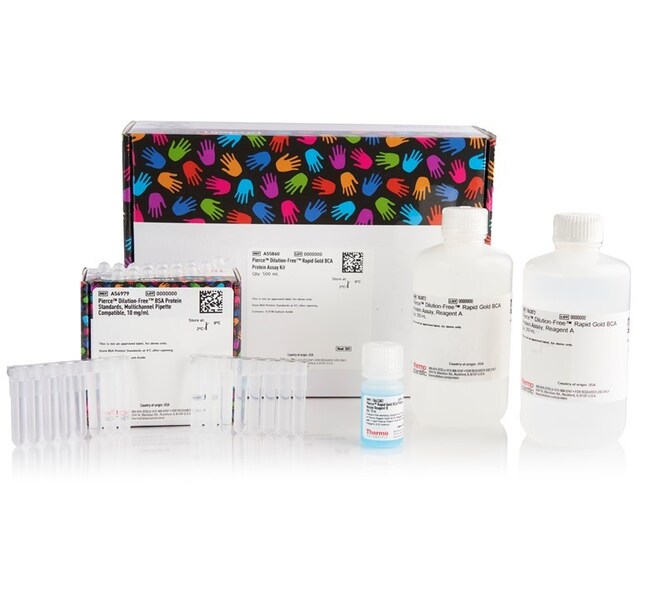
The Pierce Dilution-Free Rapid Gold BCA Protein Assay Kit is an effortless, fast, and accurate assay optimized to determine total protein concentration. It is detergent-compatible and has a 5X wider dynamic range than traditional protein assays of 0.02–10 mg/mL. This wide dynamic range eliminates the need to dilute most samples to get them into range of the assay.
Additionally, the Dilution-Free Rapid Gold BCA Protein Assay comes with a set of seven pre-diluted BSA protein standards packaged in a multichannel pipette-friendly tubestrip, so no serial dilutions are required. The tubestrip includes a single empty tube that enables users to add their own sample buffer for the purpose of blank subtraction.
Features of the Dilution-Free Rapid Gold BCA Protein Assay Kit include:
• Dilution-free—eliminates the need for sample and standard curve dilutions, reducing set-up time by up to 80%
• Short assay time—five-minute, room temperature reaction
• Wide assay range—linear working range for BSA of 20 to 10,000 μg/mL
• Uniform—exhibits similar protein-to-protein variation as traditional BCA Protein Assay and less protein-to-protein variation than dye-binding protein assay methods (Bradford)
• Compatible—unaffected by typical concentrations of most ionic and non-ionic detergents
• Colorimetric—optimal absorbance at 480 nm
• Accurate—2X more accurate than Bradford assays
The Pierce Dilution-Free Rapid Gold BCA Protein Assay Kit uses the same copper-chelating technology as the well-known traditional Pierce BCA Protein Assay and provides comparable accuracy, but with a five-minute, room temperature incubation and measured at 480 nm. This improvement eliminates the need to perform serial or sample dilutions, endure a lengthy incubation period, or expose the samples to elevated temperatures yielding faster time to results.
Compare all available BCA protein assays ›
The traditional BCA Protein Assay is a widely used and accepted protein assay, trusted for its highly accurate protein concentration determination and compatibility with most sample types encountered in protein research. However, in order to develop the samples in this traditional protocol, one must either heat the reaction at 37°C for 30 minutes or allow room temperature development for two hours. The Dilution-Free Rapid Gold BCA Protein Assay maintains the key characteristics of the traditional BCA assay but allows a fast time and room temperature incubation equal to dye-binding methods.
The Dilution-Free Rapid Gold BCA Assay can be used to assess yields in whole cell lysates and affinity-column fractions, as well as to monitor protein contamination in industrial applications. Similar to the traditional BCA assay, the Dilution-Free Rapid Gold BCA Assay is affected much less than dye-binding methods by protein compositional differences, providing low protein-to-protein variation.
How the Dilution-Free Rapid Gold BCA Protein Assay detects protein
The Dilution-Free Rapid Gold BCA Protein Assay uses the same copper reduction method as the traditional BCA Protein Assay with a unique copper chelator. The assay combines the well-known reduction of Cu2+ to Cu1+ by protein in an alkaline medium with the highly sensitive and selective colorimetric detection of the cuprous cation (Cu1+) by the proprietary chelator. The first step is the chelation of copper with protein in an alkaline environment to form a light green complex. In this reaction, known as the biuret reaction, peptides containing three or more amino acid residues form a colored chelate complex with cupric ions in an alkaline environment containing sodium potassium tartrate.
In the second step of the color development reaction, the Dilution-Free Rapid Gold BCA chelator reacts with the reduced (cuprous) cation that was formed in step one. The intense gold-colored reaction product results from the chelation of two molecules of BCA with one cuprous ion. The BCA/copper complex is water soluble and exhibits a strong linear absorbance at 480 nm with increasing protein concentrations. The complex is approximately 100 times more sensitive (lower limit of detection) than the pale green color of the first reaction.
The reaction that leads to the color formation is strongly influenced by four amino acid residues (cysteine, cystine, tyrosine, and tryptophan) in the amino acid sequence of the protein. However, unlike the Coomassie dye-binding methods (i.e. Bradford), the universal peptide backbone also contributes to color formation, helping to minimize variability caused by protein compositional differences.
Compatibility of the Dilution-Free Rapid Gold BCA Protein Assay
Certain substances are known to interfere with the Dilution-Free Rapid Gold BCA Protein Assay, including those with reducing potential, chelating agents, and strong acids or bases. Because they are known to interfere with protein estimation at even minute concentrations, avoid the following substances as components of the sample buffer:
• Ascorbic acid
• EGTA
• Iron
• Impure sucrose
• Catecholamines
• Impure glycerol
• Lipids
• Tryptophan
• Creatinine
• Hydrogen peroxide
• Melibiose
• Tyrosine
• Cysteine
• Hydrazides
• Phenol red
• Uric acid
• TCEP
• Thimerosal
• 2-mercaptoethanol
Pierce Dilution-Free Tubestrip Holder
The Pierce Dilution-Free Tubestrip Holder is a reusable foam stand for use with the Pierce Dilution-Free BSA Protein Standards and is included with the 20 mL trial size of the Pierce Dilution-Free Rapid Gold BCA Protein Assay Kit. It is also available for sale separately. Protein standard concentrations are printed on the Tubestrip Holder for easy reference and pipetting on the benchtop.
Related products
Pierce Dilution-Free BSA Protein Standards, Multichannel Pipette Compatible, 0.125–10 mg/mL
Pierce Dilution-Free Tubestrip Holder
| Code | Description |
|---|---|
| A55860 | Catalog Number: A55860 |
| A55862 | Catalog Number: A55862 |
| A55861 | Catalog Number: A55861 |


